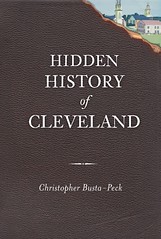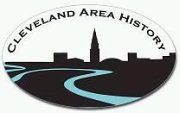
When I came across this house, at 15002 Sylvia Avenue, in Cleveland, Ohio, a year ago, I knew that it was historic, but I knew little more. The style suggests a pre-Civil War construction date. The County Auditor's records confirm this, listing the date as 1855 - though it's possible that it was earlier.
I assumed that the structure had been moved, given that the street it's on didn't exist at the time it was built. My opinion has changed. I now believe that it's the location of the front door that has changed. On the side of the house, shown in this photograph, we can see two windows, of proportions that one might expect of a house built between 1830 and 1860. I believe that the front doorway was originally located between these windows, facing what is now East 152nd Street.
Given the use of facing brick, it's hard to tell what the side of the house that faces Sylvia Avenue might have looked like. We can be reasonably sure, however, that the placement of the second floor windows remains unchanged.

In September, I came across this house, at 15006 Westropp Avenue. Notice how similar the proportions between the two are. The likeness may be seen most obviously on the side of the structure facing us, in the second floor windows. Again, I'm unsure as to the date of construction, but it was definitely pre-1860.
At the time that these houses were built, the land was owned by members of the McIlrath family. This, and the similarity in style, strongly suggests that the builder was the same. This makes the houses considerably more special - while it's possible to identify similar works by a master builder, it's much more difficult make such connections with those constructed by the average carpenter.

Detail from the 1858 Hopkins Map of Cuyahoga County. Used courtesy of Rails and Trails, original courtesy of the Bedford Historical Society.
This detail of the 1858 Hopkins Map of Cuyahoga County shows the neighborhood in question. The pair of vertical lines running through the center of the image represent East 152nd Street, which jogs to the right as Waterloo Avenue, and then becomes East 156th Street. The black squares represent houses and other major structures.
The house at 15002 Sylvia Avenue is located on a 47 acre parcel, outlined in light green, that was owned, in 1858, by one T. McIlrath. The other house, 15006 Westropp Avenue, is located on a 79 acre parcel owned by one A. Dille.

Outlined in light blue is the parcel owned by Leonard Parks, shown here.

A 107 acre parcel is outlined in dark blue. A pre-1860 structure is still standing on this property as well, the more southern of the two shown on the map. It is located at 381 East 156th Street.
There are a few neighborhoods in Cleveland that are known for large concentrations of historic homes. Outside these areas, it is rare to find two historic homes close together. A group of four, as we have here, is even more significant.
Further research on this group of historic structures, especially the two built for the McIlraths, is definitely warranted.




Great work, Christopher. Yes, this area of the city has been overlooked for historical houses. Regarding the Sylvia Ave house, There is also the possibility that an eave-front door did not lay between the two current windows, but in place of one of them. If so, it was built as a half-cape: narrow eave-front house with an un-centered door and two windows flanking it to one side. In any event, these are significant finds.
ReplyDeleteNice to see you back to posting, Christopher!
ReplyDeleteRoy, that is an excellent point. These structures are worthy of further investigation.
ReplyDeleteBob Rose, a CAH reader, today reminded me that during the summer of 1813 (War of 1812), a British Navy warship approached the shoreline at McIlrath Creek. She put off a small boat & crew to go ashore for provisions. They commandeered one of Thomas McIlrath's oxen. While none of your featured houses had been built at that time, the Sylvia Ave house (raised on a small portion of the original T. McIlrath property) may stand sentinel to a small UK debt yet owed in these parts. This house embodies untold stories. Indeed all such houses are troves of local history. Great to identify and document all of them--and work to preserve as is possible.
ReplyDeleteI've just spent a good chunk of time catching up on your blog. It makes me proud to have been a librarian (although I don't really think you quit!) I worked as a library assistant at Arlington Branch under Fritz Stein and Joyce Johnson while I was going to library school at Western Reserve. So it is not even my Main Place, but the loving investigations you make, and how you are able to find the time is a true inspiration!
ReplyDeleteVery interesting!
ReplyDeleteRegarding your post about the Sylvania house, you said, "The style suggests a pre-Civil War construction date."
Could someone please explain what the 'style' of this house is that indicates pre-Civil War era.
It's a combination of factors, including a roof with a relatively shallow pitch, a rectangular shape without any real additions, and a relatively small size. It's hard to explain exactly. I recommend looking at A Field Guide to American Houses by Virginia and Lee McAlester for a more in-depth look. They explain it far better than I can.
ReplyDeleteYou might like to know that the house on Westropp is currently abandoned. I do not know if it is on the demo list yet. It might be of interest to you. You might be able to save it and restore it or at least be able to get in and see what the inside looks like now.
ReplyDeleteThanks! Actually, I did, back in November. Here's the story.
ReplyDelete